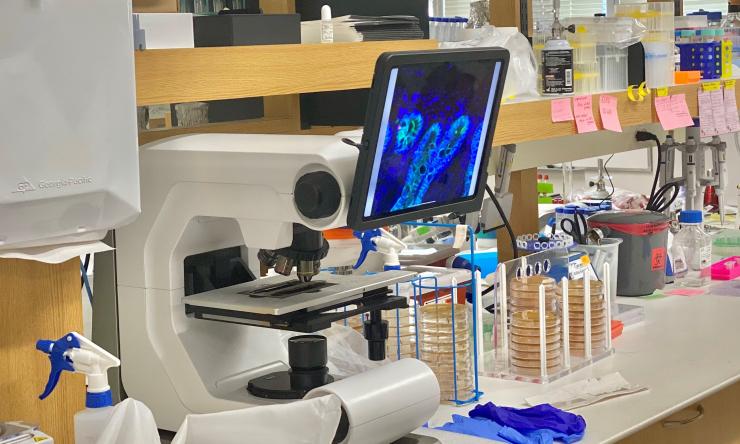ERR-gamma ‘trains’ stomach stem cells to become acid-producing cells
Common conditions such as indigestion and heartburn as well as peptic ulcers, autoimmune gastritis and stomach and esophageal cancers have one thing in common – they involve disruptions of the normal activity of parietal cells (PCs) in the stomach, the only cells in the body that produce acid. Despite their medical importance, little is known about the molecular and genetic pathways that direct the generation and maturation of PCs from stem cells.
Looking to gain new insights into the generation of PCs, researchers at Baylor College of Medicine and collaborating institutions identified the genes that were preferentially expressed by emerging PCs to guide their development. They discovered a ‘training program’ driving PC development from stem cells and subsequent maturation into active acid-secreting cells. Published in Cell Stem Cell, the findings can lead to new strategies to regulate PC function in different disease settings.
“PCs secrete hydrochloric acid, which generates the strongly acidic environment in the stomach with beneficial effects, such as killing bacteria in contaminated food, facilitating food digestion and promoting absorption of minerals including phosphate, calcium and iron. But acid can also be dangerous, causing conditions from reflux to peptic ulcers to gastric bleeds that can be life-threatening,” said corresponding author Dr. Jason Mills, Herman Brown Endowed Professor of medicine – gastroenterology and co-director of the Texas Medical Center Digestive Disease Center (DDC) at Baylor.
Studying how these cells are generated can help scientists understand conditions in which the stomach stops making PCs, which results in an acid-free stomach that promotes gastric cancer. Or the opposite, conditions in which the stomach makes too many PCs and too much acid.
“Our first step was to generate enough PCs to study their development and maturation,” said co-first author of the study, Dr. Mahliyah Adkins-Threats, a graduate student in the Mills lab while she was working on this project. “PCs are long-lived (about two months), so we needed a system that would allow us to characterize the PC differentiation process in a shorter time.”
The researchers worked with a mouse model in which they eliminated existing PCs. “This triggered the production of new cells in which we were able to capture a first glimpse into the molecular and morphological steps involved when cells in the gastric epithelium commit to becoming PCs and then mature,” Adkins-Threats said.
Using single-cell RNA sequencing, a technique to identify the genes expressed by a cell, the team identified what genes the cells were turning on or off as they became more mature PCs.
The researchers discovered that of all the genes expressed by the cells, there was one, estrogen-related receptor gamma (ERRγ), a gene involved in regulating cell metabolism, that was expressed in both very young parietal cells and in fully functional parietal cells. ERRγ was sufficient for the cells to develop into PCs.
“Progenitor PC cells that were committed to expressing ERRγ, were destined to eventually become mature PCs,” said Mills, a member of and co-associate director for cancer education at the Dan L Duncan Comprehensive Cancer Center. “Our findings indicate that ERRγ is responsible for regulating the differentiation and maturation of these acid secreting PCs.”
“Importantly, when we deleted the Esrrg gene in the gastric epithelium, whole gastric sections completely lacked any PC lineage cells, indicating that this gene is not only sufficient but also required for stem cells to commit to the PC lineage,” Adkins-Threats said. “We see ERRγ as the ‘trainer’ of these young stem cells; it’s the one gene that orchestrates the dynamics of the metabolic pathways that shape stem cells into fully mature PCs.”
Co-first author Sumimasa Arimura, Yang-Zhe Huang, Margarita Divenko, Sarah To, Heather Mao, Yongji Zeng, Jenie Y. Hwang, Joseph R. Burclaff and Shilpa Jain also contributed to this work. The authors are affiliated with one of the following institutions: Baylor College of Medicine, Washington University at St. Louis, University of North Carolina at Chapel Hill, North Carolina State University, University of Texas Health at San Antonio and Cincinnati Children's Hospital Medical Center.
This study was supported by the following grants: National Science Foundation-Graduate Research Fellowship Program DGE-2139839/1745038, as well as multiple grants from the National Institutes of Health including: T32 DK077653, T32 GM007067, a pilot award from the NIDDK-funded DDC (P30 DK56338), NIDDK R01 DK094989 and DK110406 and NCI R01 CA239645.










